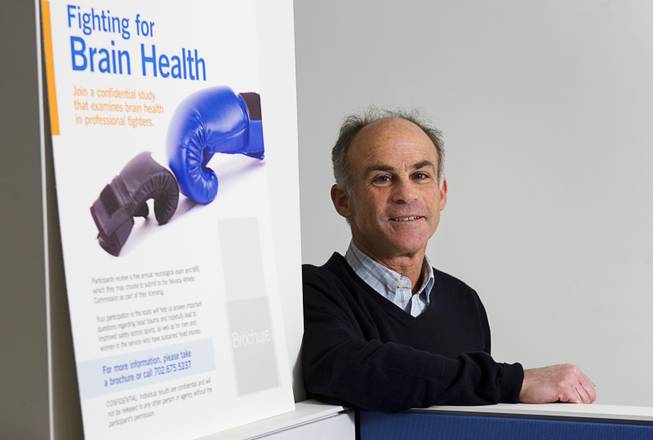
Neurologist Charles Bernick, principal investigator of the Professional Fighters Clinical Research Study, at the Cleveland Clinic Lou Ruvo Center for Brain Health on Friday, Feb. 10, 2012.
Friday, April 20, 2012 | 12:25 p.m.
Initial results from a landmark study being conducted on boxers and mixed martial arts fighters at the Ruvo brain center show there may be a starting point where repeated blows to the head begin affecting memory and cognition.
Results from the first year of Professional Fighters Brain Health Study, which involved 35 boxers and 43 mixed martial arts athletes, will be presented next week at the American Academy of Neurology’s annual meeting.
The study used MRI technology and cognitive testing, along with records from fights, to track the long-term effects fighters suffer from repeated blows to the head and how that leads to chronic traumatic encephalopathy (CTE), a degenerative brain condition linked to memory loss, aggression and difficulty thinking.
“The brain may be able to absorb a certain amount of trauma before you start seeing changes,” said study author Dr. Charles Bernick, associate medical director of the Cleveland Clinic Lou Ruvo Center for Brain Health. “There may be certain points or certain tolerances brains have, and if you exceed them, then you start this progressive downhill course.”
Bernick emphasized that the study was still in its early stages and that its findings were generalized to the entire study group, not to any specific participants.
Little is known about CTE, including how exactly it develops and whether there are any possible treatments that can help mitigate its progress, Bernick said. The disease affects athletes of all types, including football and hockey players, and findings from the study someday might aid in the treatment of repetitive brain trauma suffered by military members or civilians, he said.
The Ruvo Center study organized the fighters into groups based on how long they had been fighting. Results showed a relationship between a higher number of fights and lower brain volume developing as early as six years after beginning fighting regularly. But it was only after 12 years that many of symptoms of cognitive decline showed up in testing, suggesting a window when early damage can be identified.
“The implication is that changes are beginning in the brain that are detectable years before we get symptoms,” Bernick said. “If you can intervene before that point, you may be able to avert long term complications.”
Bernick said the study had the potential to help athletes and regulatory agencies better understand the long-term effects of repeated blows to the head and eventually develop measures to help protect fighters. The study also aims to identify factors that would make a fighter more prone to suffering long-term damage.
“In the long run, we hope to be able to identify who’s at greatest risk and what measures might predict that a person’s on their way to these chronic brain diseases,” he said.
The four-year study currently has about 175 fighters enrolled, and Bernick said the plan was to eventually push that number to more than 600. Over the next year, a control group of nonfighters will be added to the study along with another group of retired fighters, which will give researchers more data points to explore the progression of CTE.
“This will give us a spectrum to study the disease on,” he said.

Join the Discussion:
Check this out for a full explanation of our conversion to the LiveFyre commenting system and instructions on how to sign up for an account.
Full comments policy